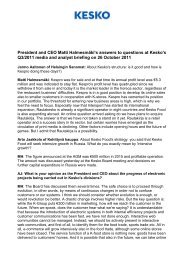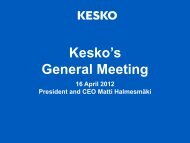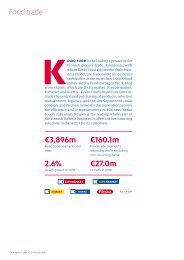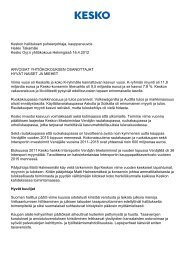Create successful ePaper yourself
Turn your PDF publications into a flip-book with our unique Google optimized e-Paper software.
Year <strong>2007</strong><br />
Economic value added formula:<br />
Operating profit excluding non-recurring items<br />
less operational taxes<br />
less return requirement for average restricted capital<br />
+/- other adjustment items<br />
Divisions The Group<br />
Financial<br />
statements<br />
Further information<br />
The objectives for the Group's solvency and liquidity are set with the purpose<br />
of securing the Group's liquidity in all market situations, enabling<br />
the implementation of investment programmes based on the Group's<br />
strategy and maintaining the shareholder value. Objectives have been set<br />
to equity ratio (target 40–45%) and interest-bearing net debt/operating<br />
margin (target < 3). The calculation formulas for these indicators are presented<br />
in the financial statements, p. 130. The Group's interest-bearing<br />
debt include covenants, whose terms and conditions have been taken<br />
into account in the target levels. The Group does not have a credit rating<br />
given by any external credit rating institution.<br />
The above target levels set for consolidated financial indicators are<br />
revised annually as part of the Group's strategy process and changes are<br />
submitted for approval to the Group's Board of Directors.<br />
Target level <strong>2007</strong> 2006<br />
Return on equity 14% 12%<br />
Return on invested capital 16% 12%<br />
Equity ratio 40–45% 40–45%<br />
Interest-bearing net debt/operating<br />
margin < 3 < 3<br />
Note 45<br />
Risk management<br />
<strong>Kesko's</strong> risk management policy<br />
The risk management policy approved by the Board of Directors guides<br />
risk management in the Kesko Group. The divisions have assessed the<br />
risks in connection with the strategy cycle and have updated their risk<br />
assessments quarterly. Separate risk analyses have been made for major<br />
projects. Also the Group units have analysed the risks threatening the<br />
objectives and their management.<br />
On the basis of the Divisions' and Group units' risk analyses, the Corporate<br />
Risk Management Unit has prepared summaries of major risks<br />
and their management on a quarterly basis for Kesko Corporation's<br />
Board of Directors' Audit Committee. <strong>Kesko's</strong> Corporate Management<br />
Board has analysed and prioritised the major risks of the Group.<br />
Risks and their management<br />
The Kesko Group's risk analyses have, for example, addressed the following<br />
risks and their management in <strong>2007</strong>.<br />
Delivering the customer promise<br />
The price-quality ratio is a key competitive factor. If Kesko does not succeed<br />
in this competition, it will not achieve the sales targets. The general<br />
cost development can also endanger the implementation of objectives.<br />
Enhancing price competitiveness calls for improvements in the efficiency<br />
of operations throughout the supply chain from the supplier to<br />
the store shelf.<br />
125<br />
Product safety and quality of the supply chain<br />
<strong>Kesko's</strong> goal is to provide safe products for its customers. A failure in the<br />
quality assurance of the supply chain or in product control may result in<br />
financial losses, the loss of customer confidence or, in the worst case, a<br />
health hazard. Product research, the trading sector's self-control and<br />
manufacturer audits ensure the quality and safety of the products sold.<br />
Store sites<br />
Store sites are a strategic competitive factor. Considerable amounts of<br />
capital are tied up in store properties for decades. Local competitive situations<br />
can change fast and there is a risk that operations at the store site<br />
will become unprofitable. The risk is managed by long-term planning of<br />
the store network, by careful preparation of each store site investment<br />
decision and by applying a sale and lease back approach.<br />
The acquisition of new store sites can be delayed not only by shortage<br />
of sites, town planning and permit practices, but also by the price trends<br />
of sites and construction. Different countries also have their specific features.<br />
Online sales are growing, which affects the store network. Success<br />
in e-commerce requires a completely new kind of business expertise,<br />
logistics and information security solutions.<br />
Suppliers and distribution channels<br />
In business divisions that are strongly dependent on individual principals<br />
and suppliers, changes in a principal's or supplier's strategy concerning<br />
the product selection, pricing and distribution channel solutions<br />
can mean a reduction in competitiveness or sales or loss of business.<br />
Good market shares, growing sales and development of operations create<br />
a basis for long-term cooperation.<br />
Shrinkage<br />
Shrinkage is a significant problem in the retail trade. Shrinkage can<br />
result from spoilage or breakage of goods, theft or other malpractice, and<br />
unsuccessful purchasing, for example. The most important loss prevention<br />
activities include uniform measuring and monitoring of shrinkage,<br />
and the consequent development and introduction of new management<br />
methods.<br />
Internationalisation<br />
Internationalisation aims at growth either through business acquisitions<br />
or expanding the existing store network. Success in international<br />
growth requires careful planning of acquisitions and expansion projects,<br />
resources and risk management. Challenges include different cultures,<br />
local business practices, authorities' actions and fast-changing operating<br />
environments. Finnish retail trade operating processes and control practices<br />
cannot always be introduced as such outside Finland. The efficient<br />
steering of operations and the achievement of synergy benefits require<br />
implementation of common practices and information systems across<br />
country and organisational boundaries.<br />
Personnel<br />
Competition for skilled employees has intensified in the labour market.<br />
Recruiting competent employees and retaining their commitment is<br />
challenging particularly in the Baltic countries and Russia. Implementation<br />
of strategies requires competent and motivated personnel. There is a<br />
risk that the trading sector will not attract the most skilled people. Specialisation<br />
increases dependence on the competence of individuals. In<br />
updating strategies, the competencies required to implement the strat-















